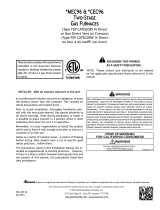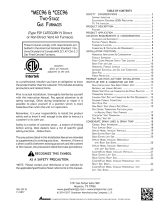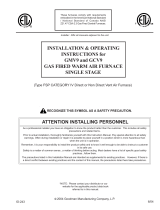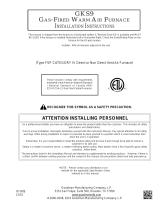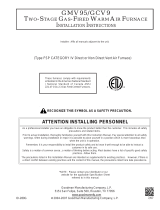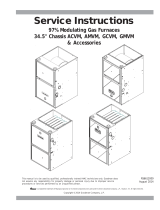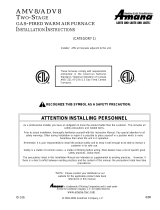
15
4. Use a knockout tool to create a 3" diameter hole
5. Install combustion air flange and secure with screws
removed in step one.
NON-DIRECT VENT (SINGLE PIPE) PIPING
Non-direct vent installations require only a vent/flue pipe. The
vent pipe can be run horizontally with an exit through the side of
the building or run vertically with an exit through the roof of the
building. The vent can also be run through an existing unused
chimney; however, it must extend a minimum of 12 inches above
the top of the chimney. The space between the vent pipe and the
chimney must be closed with a weather-tight, corrosion-resistant
flashing.
Although non-direct vent installations do not require a combus-
tion air intake pipe, a minimum of one 90° elbow should be at-
tached to the furnace’s combustion air intake if: an upright in-
stallation uses the standard intake location, or a horizontal instal-
lation uses the alternate air intake location. This elbow will guard
against inadvertent blockage of the air intake.
VENT/FLUE PIPE LENGTHS AND DIAMETERS
NOTE: If either a 90 degree or 45 degree elbow is used for
termination, it must be pointed downward.
Refer to the Direct and Non-Direct Vent Table for applicable
length, elbows, and pipe diameter for construction of the vent/
flue pipe system of a non-direct vent installation. In addition to
the vent/flue pipe, a single 90° elbow should be secured to the
combustion air intake to prevent inadvertent blockage. The tee
used in the vent/flue termination must be included when deter-
mining the number of elbows in the piping system.
VENT/FLUE PIPE TERMINATIONS
NOTE: If either a 90 degree or 45 degree elbow is used for
termination, it must be pointed downward.
The vent/flue pipe may terminate vertically, as through a roof, or
horizontally, as through an outside wall.
Vertical vent/flue pipe terminations should be as shown in the
following figure. Refer to Vent/Flue Pipe and Combustion Air
Pipe - Termination Locations for details concerning location re-
strictions. The penetration of the vent through the roof must be
sealed tight with proper flashing such as is used with a plastic
plumbing vent.
Horizontal vent/flue pipe terminations should be as shown in the
following figure. Refer to Vent/Flue Pipe and Combustion Air Pipe.
To secure the pipe passing through the wall and prohibit damage
to piping connections, a coupling should be installed on either
side of the wall and solvent cemented to a length of pipe connect-
ing the two couplings. The length of pipe should be the wall
thickness plus the depth of the socket fittings to be installed on
the inside and outside of the wall. The wall penetration should
be sealed with silicone caulking material.
NOTE: Terminate both pipes in the same pressure zone (same side of roof, no major obstacles between pipes, etc.).
B
E
SURE
NOT
TO
DAMAGE
INTERNAL
WIRING
OR
OTHER
COMPONENTS
WHEN
REINSTALLING
COUPLING
AND
SCREWS
.
CAUTION
MODEL
PIPE
SIZE
12345678
2 165 160 155 150 145 140 135 130
3 168 161 154 147 140 133 126 119
25550454035302520
3 127 120 113 106 99 92 85 78
23025201510 5N/AN/A
37265585144373023
23025201510 5N/AN/A
37265585144373023
240353025201510 5
37265585144373023
26055504540353025
3 168 161 154 147 140 133 126 119
23025201510 5N/AN/A
3 113 106 99 92 85 78 71 64
2 N/A N/A N/A N/A N/A N/A N/A N/A
36558514437302316
2 100 95 90 85 80 75 70 65
3 137 130 123 116 109 102 95 88
26055504540353025
3 127 120 113 106 99 92 85 78
2353025201510 5N/A
3 160 153 146 139 132 125 118 111
2 N/A N/A N/A N/A N/A N/A N/A N/A
3 127 120 113 106 99 92 85 78
MODEL
PIPE
SIZE
12345678
2 100 95 90 85 80 75 70 65
3 168 161 154 147 140 133 126 119
24540353025201510
3 168 161 154 147 140 133 126 119
2353025201510 5N/A
3 168 161 154 147 140 133 126 119
26055504540353025
3 113 106 99 92 85 78 71 64
24540353025201510
3 120 113 106 99 92 85 78 71
240353025201510 5
3 151 144 137 130 123 116 109 102
2 N/A N/A N/A N/A N/A N/A N/A N/A
3 158 151 144 137 130 123 116 109
2 100 95 90 85 80 75 70 65
3 137 130 123 116 109 102 95 88
24540353025201510
3 168 161 154 147 140 133 126 119
240353025201510 5
3 120 113 106 99 92 85 78 71
2 N/A N/A N/A N/A N/A N/A N/A N/A
3 113 106 99 92 85 78 71 64
2 N/A N/A N/A N/A N/A N/A N/A N/A
3 110 103 96 89 82 75 68 61
*MSS960803BN
*MSS960804BN
*MSS960805CN
*MSS961005CN
*CSS961005CN
*CSS961205DN
*MSS961205DN
*CSS960402BN
*CSS960603BN
*CSS960804CN
*CSS920402BN
*CSS920603BN
*CSS920804CN
*CSS921005CN
*MSS960402BN
Number of Elbows
(3) (5)
*MSS920402BN
*MSS920603BN
*MSS960603BN
*MSS920803BN
*MSS920804CN
*MSS920805CN
*MSS921004CN
*MSS921005CN
*MSS921205DN
1) Maximum allowable limits listed on individual lengths for inlet and flue and
NOT a combination.
2) Minimum requirement for each vent pipe is five (5) feet in length and one
elbow/tee.
3) Tee used in the vent/flue termination must be included when determining
the number of elbows in the piping system.
4) 2 1/2” or 3” diameter pipe can be used in place of 2” diameter pipe.
5) Increased Clearance Configurations using (2) 45 deg. Long Sweep elbows
should be considered equivalent to one 90 deg. elbow.
*MSS9* / *CSS9 Direct Vent (2-Pipe) & Non-Direct Vent (1-Pipe)
(6)
Maximum Allowable Length of Vent/FLue Pipe





















